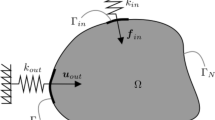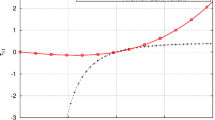Abstract
This paper presents a line-element-based approach to the topology synthesis of electrothermal compliant (ETC) mechanisms. A line element is a one-dimensional model of the electrical, thermal, and elastic behavior of a beam-like continuum. In contrast to topology synthesis of ETC mechanisms by a continuum-element-based approach, the line-element-based approach offers significant conceptual and practical advantages. The line element allows for straightforward modeling of surface heat transfer in the topology optimization framework. It also obviates the need to interpolate electrical and thermophysical properties in the topology synthesis procedure. Moreover, this approach results in clean geometries that are easy to fabricate directly in their optimized form.
Solutions obtained from this procedure are compared with results from continuum-based optimal synthesis procedures as well as intuitive designs reported in the literature. A number of design examples are used to demonstrate the ability of the procedure to generate nonintuitive topologies. The synthesis procedure is also used to study the influence of the direction of output and the electrical and thermal resistance of the workpiece on the resulting optimal topologies.
Similar content being viewed by others
References
Ananthasuresh, G.K. 1994: A new design paradigm for microelectromechanical systems and investigations on the compliant mechanisms synthesis. Ph.D. dissertation, The University of Michigan, Ann Arbor, MI, USA
Coleman, T.; Branch, M.A.; Grace, A. 1999: Optimization Toolbox User’s Guide, Ver. 2. The Mathworks Inc, Natick, MA 01760-1500, USA
Comtois, J.; Bright, V. 1996: Surface micromachined polysilicon actuator arrays and applications. Technical Digest of the 1996 Solid State Sensors and Actuators Workshop, Hilton Head, SC, June 3–6, 1996, pp. 174–177
Frecker, M.I.; Ananthasuresh, G.K.; Nishiwaki, S.; Kikuchi, N.; Kota, S. 1997: Topological synthesis of compliant mechanisms using multi-criteria optimization. ASME J. Mech. Des. 119, 238–245
Guckel, H.; Klein, J.; Christenson, T.; Skrobis, K.; Laudon, M.; Lovell, E.G. 1992: Thermo-magnetic metal flexure actuators. Technical Digest of the 1992 Solid State Sensor and Actuator Workshop, Hilton Head, SC, June 13–16, 1992, pp. 73–75
Hetrick, J.A.; Kota, S. 1999: An energy formulation for parametric size and shape optimization of compliant mechanisms. ASME J. Mech. Des. 121(2), 229–234
Jonsmann, J.; Sigmund, O.; Bouwstra, S. 1999: Compliant electrothermal microactuators. Proc. of the 1999 IEEE MEMS Conference, Orlando FL, January 1999, pp. 588–593
Kovalenko, A.D. (translated from Russian by Macvean, D.B.) 1995: Thermoelasticity. Basic theory and applications, The Netherlands: Wolters-Noordhoff, Groningen
Mankame, N.D.; Ananthasuresh, G.K. 2001: Comprehensive thermal modelling and characterization of an electro-thermal-compliant microactuator. J. Micromech. Microeng. 11(5), 452–462
Moulton, T.; Ananthasuresh, G.K. 2001: Micromechanical devices with embedded electro-thermal-compliant actuation. Sensors and Actuators A: Physical 90(1–2), 38–48
Que, L.; Park, J.-S.; Gianchandani, Y.B. 1999: Bent-beam electrothermal actuators for high force applications. Proc. of the 1999 IEEE MEMS Conference, Orlando FL, January 1999, pp. 31–36
Saxena, A.; Ananthasuresh, G.K. 2000: On an optimal property of compliant topologies. Struct. Multidisc. Optim. 19(1), 36–49
Senturia, S.D. 1985: Microsystem design. Kluwer Academic Publishers, USA, pp. 663–664
Shames, I.H.; Dym, C.L. 1985: Energy and finite element methods in structural mechanics. USA: Hemisphere Publishing Corp./ McGraw Hill Book Co.
Sigmund, O. 1997: On the design of compliant mechanisms using topology optimization. Mech. Struct. & Mach. 25(4), 493–524
Yin, L.; Ananthasuresh, G.K. 2001: Topology optimization of compliant mechanisms with multiple materials using a peak function material interpolation scheme. Struct. Multidisc. Optim. 23(1), 49–62
Author information
Authors and Affiliations
Corresponding author
Rights and permissions
About this article
Cite this article
Mankame, N., Ananthasuresh , G. Topology synthesis of electrothermal compliant mechanisms using line elements. Struct Multidisc Optim 26, 209–218 (2004). https://doi.org/10.1007/s00158-003-0340-5
Received:
Published:
Issue Date:
DOI: https://doi.org/10.1007/s00158-003-0340-5




